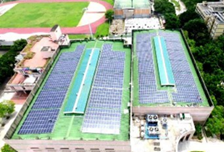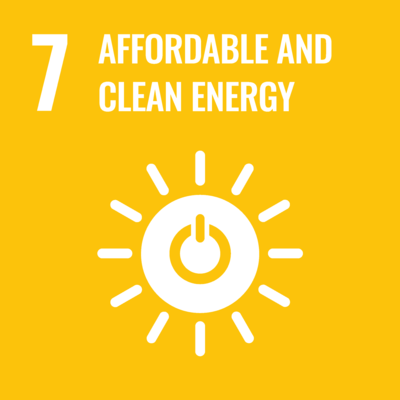SDG 7.2.2 Upgrade buildings to higher energy efficiency
1. NCUE holds an annual energy-saving and carbon-reduction meeting to evaluate plans for the replacement of existing equipment with energy-saving equivalents the following year. At least NT$5 million is invested annually to replace energy-consuming equipment, which is forecasted to achieve the goal of increasing total energy efficiency by at least 1% per year (the goal is to save 150,000 kWh(540GJ) or more annually).
(1) The school has implemented a range of major energy conservation and carbon reduction measures from 2019 to 2022. (see Table 1)
Table 1. Major Energy Conservation & Carbon Reduction Measures Implemented by NCUE between 2019-2023
|
Year |
Major Measures |
|
2023 |
(a) The air conditioning peak load shedding system are installed across all campus areas phase by phase. Upon completion, this system is expected to achieve annual electricity savings of over 100,000 kWh. (b) Plan the second phase of solar photovoltaic installation, with an expected increase of 510.04 kWp in the Jinde Campus and 473.14 kWp in the Baoshan Campus. |
|
2022 |
(a) The air conditioning peak load shedding system are installed across all campus areas phase bu phase. Upon completion, this system is expected to achieve annual electricity savings of over 100,000 kWh. (b) Replace at least 500 T5 fluorescent lamps with LED lights across all campus buildings, expecting to save over 50,000 kWh annually. (c) Routinely replace over 70 air conditioning units, expecting to save 100,000 kWh annually. |
|
2021 |
(a) Replace the 300RT water-cooled chiller and ancillary equipment in the gymnasium of the Jinde campus, which is expected to save 227,603 kWh of power annually (b) Replace the T5 lights of all buildings with LED lights, which involves at least 500 light replacements. This measure is expected to save 50,000 kWh of power annually. (c) Implement the routine replacement of all air-conditioning units with more energy-efficient units, which involves more than 50 replacements and is expected to save 75,000 kWh of power annually. |
|
2020 |
(a) Replace the water-cooled chiller and ancillary equipment in the Library and Information Center Building of the Jinde campus, which is expected to save 327,603 kWh of power annually. (b) Replace the T5 lights in the classrooms on the first floor of the gymnasium with LED lights, to save 25,028 kWh of power annually. (c) Replace 64 air-conditioning units, saving approximately 1,500 x 64 = 96,000 kWh of power |
|
2019 |
(a) Replace the T5 lights on the first and second floors of the library with LED lights to save 27,430 kWh of power annually. (b) Replace 65 air-conditioning units, saving approximately 97,500 kWh of power (c) Calibrate the equipment in the machine room of the swimming pool to sleep during closed periods to reduce annual power consumption by up to 40,000 kWh. |
(2) In response to the renewable energy policy, NCUE officially launched the solar power system on the roof of the Jinde Campus gymnasium in 2017 (as shown in Figure 1). The installation capacity is 467.28 kWp, with an expected annual power generation of 2,253.402 GJ. This initiative was featured as a highlight news story in the Changhua area. For related reports and details, please visit https://epage.ncue.edu.tw/files/16-1000-13227.php

Figure 1: The above picture shows the gymnasium’s roof with installed solar cells.
(3) In response to the national policy, NCUE plans to complete the installation of photovoltaic solar cells on the roofs of other school buildings by the end of 2022. The total capacity of the solar power system on the Jinde campus is currently at 2091.375 kWp, and that on the Baoshan campus is expected to be 571.5 kWp. In addition to reducing the net energy load of the buildings, in certain scenarios (such as off-peak months), the buildings’ energy needs can be entirely met by the solar power system. By reducing the amount of energy drawn from the main grid, local line loss can be reduced by approximately 3%, improving energy efficiency. Moreover, solar panels block direct sunlight that would otherwise be absorbed by the roof. According to research, direct sunlight on the roof can be reduced by 38% with the use of solar panels and roof temperature, consequently, can be reduced by 2.8 °C. Thus, the temperature inside the buildings can be lowered, the use of air conditioners can be reduced, and energy efficiency can be improved.
(4) The (partial) design and layout of the rooftop photovoltaic solar cells on each building in the Jinde and Baoshan campuses from 2022 are as follows: Solar Power System Installation Plan for the Jinde and Baoshan Campuses in 2022( see Table 2).
Table 2. Solar Power System Installation Plan for the Jinde and Baoshan Campuses in 2022
|
Campus |
Building |
Estimated capacity (kWp) |
Total |
Estimated power generation (kwh/year) |
Total |
|
Jinde Campus |
Qiaosi Building |
69 |
2091.375 kWp |
94,687 |
2,607,183 kWh (9,386GJ) |
|
Baisha Building |
191.625 |
239,531 |
|||
|
Zhishan Building |
48 |
60,000 |
|||
|
Mingde Building |
85.125 |
80,156 |
|||
|
Educational Building |
92.25 |
115,312 |
|||
|
No. 8 Dormitory |
189 |
236,250 |
|||
|
No. 7 Dormitory |
181.5 |
226,875 |
|||
|
No. 6 Dormitory |
88.5 |
110,625 |
|||
|
Hubin Building |
123 |
153,750 |
|||
|
Library |
133.5 |
183,281 |
|||
|
Comprehensive Center |
103.875 |
129,843 |
|||
|
Student Canteen |
146.625 |
183,281 |
|||
|
Shengyang Building |
99.375 |
124,218 |
|||
|
Xuesi Building |
36 |
45,000 |
|||
|
Wang Jinping Activity Center |
160.65 |
192,187 |
|||
|
Wang Jinping Swimming Pool |
239.4 |
302,812 |
|||
|
Old Activity Center |
103.5 |
129,375 |
|||
|
Baoshan Campus |
No. 9 Dormitory |
99.75 |
571.5 kWp |
125,625 |
714,375 kWh (2,572GJ) |
|
First Educational Building |
69.75 |
126,563 |
|||
|
Engineering College Building |
139.5 |
174,375 |
|||
|
Jingshi Building |
114.375 |
142,969 |
|||
|
Lixing Building |
148.125 |
185,156 |
(5) For the complete layout of the solar power system on the roofs of each building, please refer to Annex 7.2.2A: Layout of Photovoltaic Solar Devices on the Roofs of the Buildings in the Jinde and Baoshan campuses.
(6) The school is currently planning new rooftop and ground-mounted photovoltaic solar devices in 2023. Between 2023-2024, we expect to increase the installed capacity in the Jinde and Baoshan Campuses by 510.04kWp and 473.14kWp respectively. For the list of photovoltaic solar devices to be installed on these campuses, see Table 3.
Table 3: List of photovoltaic solar devices in NCUE’s Jinde and Baoshan Campuses
|
Campus |
New Location |
Estimated Capacity (kWp) |
Total |
Estimated Power Generation (kWh/year) |
Total |
|
Jinde Campus |
No. 3 Dormitory |
259.94 |
510.04 kWp |
324,925 |
637,550 kWh (2,295GJ) |
|
No. 5 Dormitory |
69.7 |
87,125 |
|||
|
Parking lot at the East Gate |
102.5 |
128,125 |
|||
|
Left and right sides of the Torch Tower |
77.9 |
97,375 |
|||
|
Baoshan Campus |
Behind No. 9 Dormitory |
138.99 |
473.14 kWp |
173,737 |
591,424 kWh (2,129GJ) |
|
Parking lot of the No. 9 Dormitory next to the Baoshan Road |
123.41 |
154,262 |
|||
|
Parking lot of the First Educational Building next to the Baoshan Road |
113.98 |
142,475 |
|||
|
Parking lot of the Second Educational Building |
96.76 |
120,950 |
The schedule of the solar power plant project is as follows: See Table 4.
Table 4. Schedule of NCUE Photovoltaic Solar Device Installation
|
Campus |
Year |
Newly Added Capacity (kWp) |
Accumulated Capacity (kWp) |
Estimated Annual Power Generation (GJ) |
|
Jinde Campus |
Before 2020 |
467 |
467 |
2,102 |
|
2021~2022 |
2085.75 |
2552.75 |
11,487 |
|
|
2023~2024 |
510.04 |
3062.79 |
13,783 |
|
|
Baoshan Campus |
Before 2020 |
0 |
0 |
0 |
|
2021-2022 |
571.5 |
571.5 |
2,572 |
|
|
2023-2024 |
473.14 |
1044.64 |
4,701 |
(7) The complete design and layout of the 2023-2024 solar energy project can be found in Annex 7.2.2B: 2023-2024 Solar Energy Project of NCUE Jinde Campus and Baoshan Campus.

















